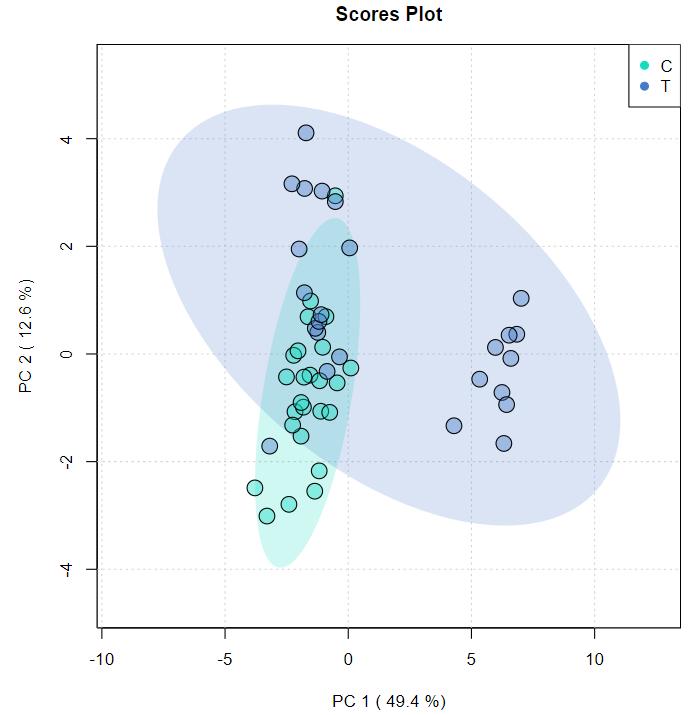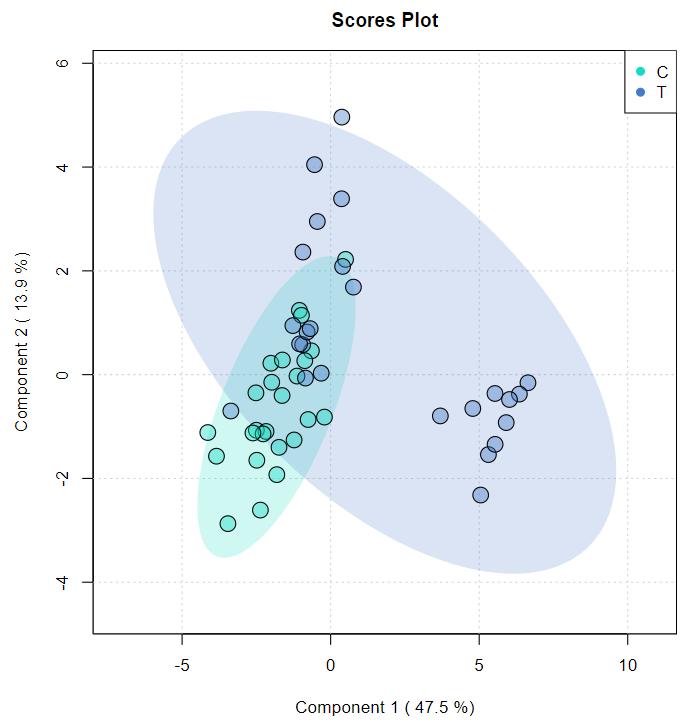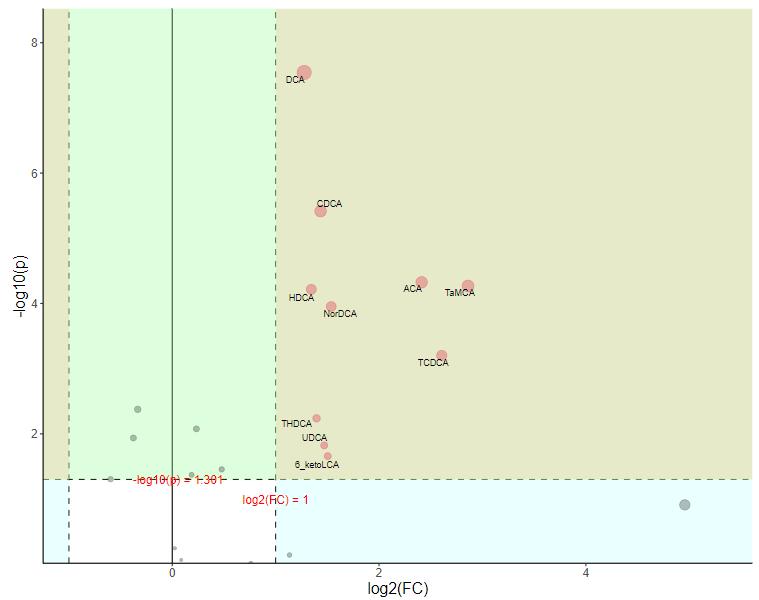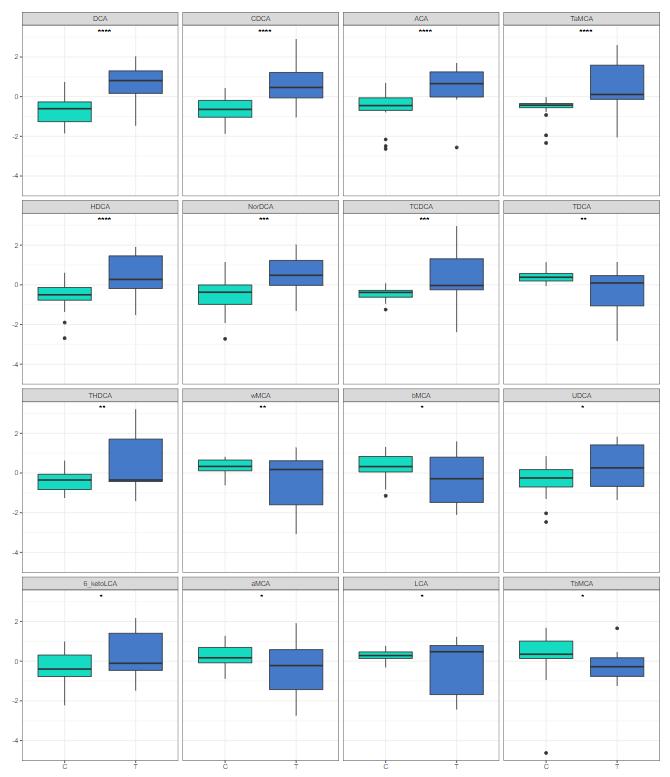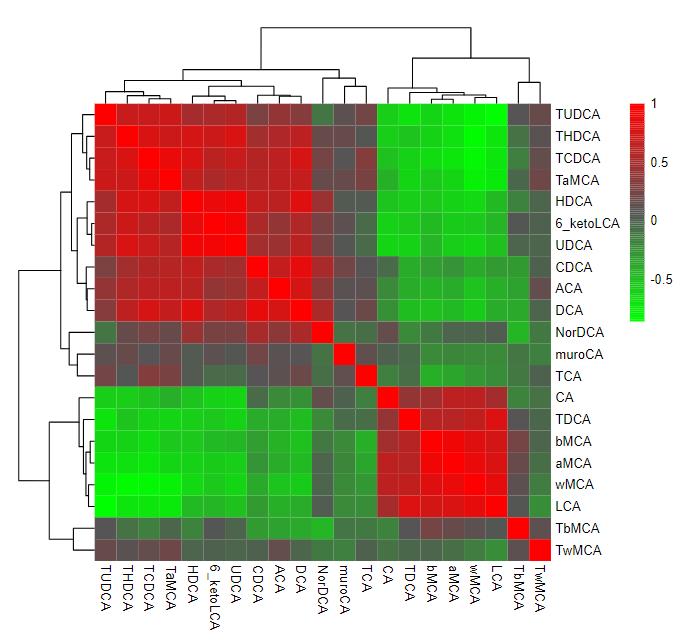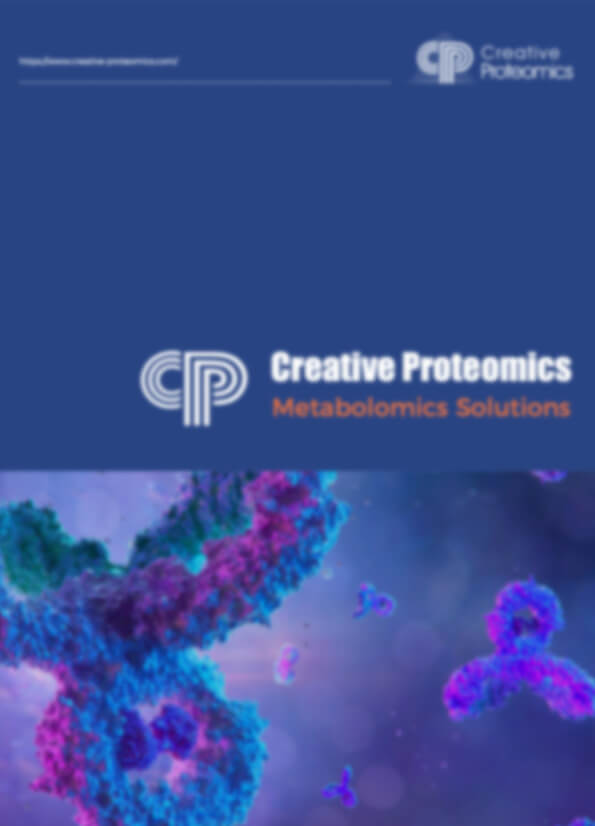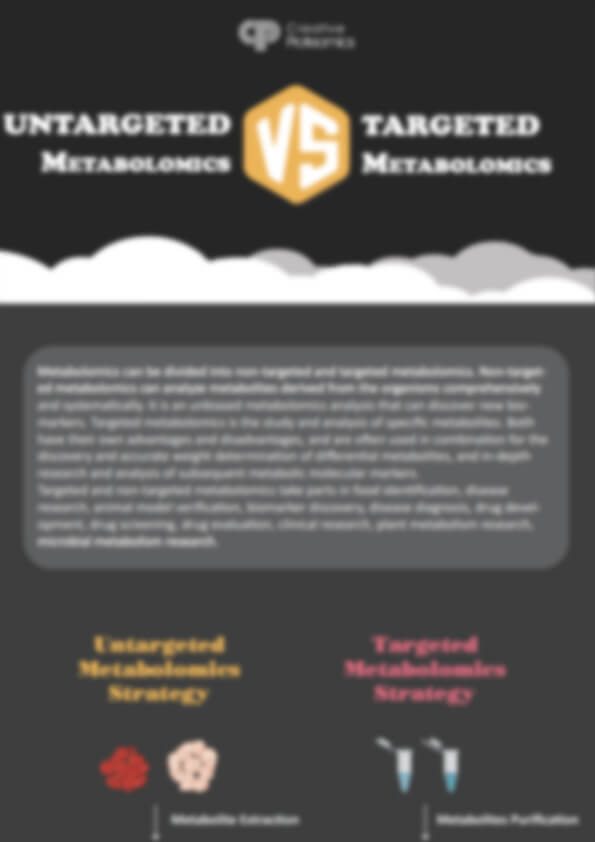Cadaverine Analysis Service
Creative Proteomics provides high-accuracy cadaverine quantification for applications in food safety, fermentation monitoring, environmental analysis, and plant stress research.
Key Advantages
- Trace-Level Sensitivity – Detect cadaverine down to 0.1 ng/mL
- Matrix-Tailored Sample Prep – Optimized for serum, food, soil, plants, and fermentation broth
- Multi-Platform Detection – LC-MS/MS, GC-MS, or UPLC-FLD based on sample type and volatility
- Dynamic Monitoring – Time-course analysis for metabolic or spoilage studies
- Comprehensive Reporting – Includes chromatograms, QC data, and expert interpretation (optional)
Ideal for researchers and industries needing reliable data on lysine decarboxylation, spoilage markers, or polyamine pathway activity. Fast turnaround and customizable workflows ensure high-quality results.
Submit Your Request Now
×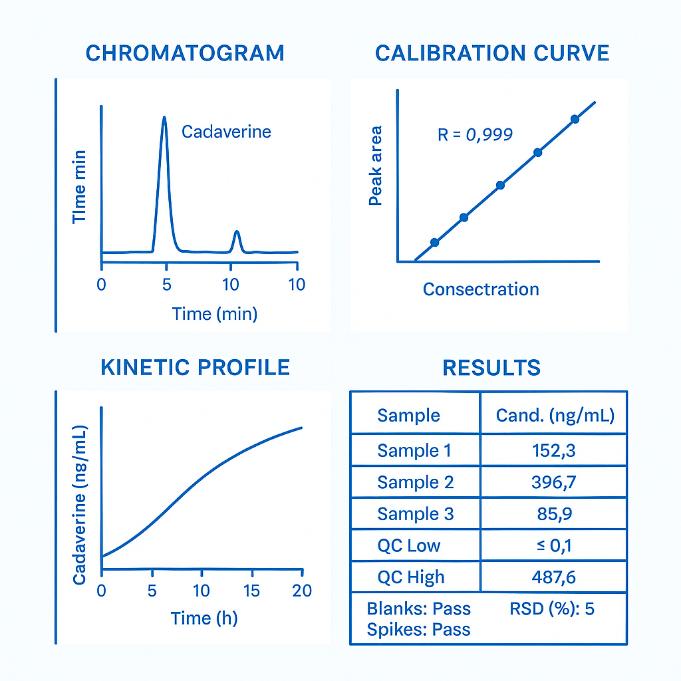
Deliverables You Can Expect:
- Quantitative cadaverine concentrations (ng/mL–ppm)
- Chromatograms with multi-point calibration
- QC metrics: blanks, replicates, spikes
- Time-course kinetic profiles
- Expert consultation on demand
- What We Provide
- Advantages
- Technology Platform
- Sample Requirement
- Demo
- Case
- FAQ
What is Cadaverine?
Cadaverine, also known by its chemical names 1,5-pentanediamine or pentamethylenediamine, is a foul-smelling diamine compound that arises primarily from the breakdown of proteins in animal tissues during putrefaction. This toxic substance was first reported by Ludwig Brieger, a Berlin-based physician, in 1885. Cadaverine is formed through the decarboxylation of the amino acid lysine, resulting in a molecule with the chemical formula NH₂(CH₂)₅NH₂. Structurally similar to putrescine, cadaverine's noxious odor and toxic nature make it a compound of interest in various fields, including toxicology, biochemistry, and medical research.
Why Analyze Cadaverine?

Fermentation Optimization & Metabolic Pathway Analysis
Cadaverine is a key indicator of lysine decarboxylation in microbial systems. Monitoring its production helps evaluate fermentation performance, optimize biosynthetic pathways, and improve the yield of bio-based chemicals and materials.

Food Freshness Monitoring & Quality Control
Cadaverine is a well-established spoilage marker in protein-rich foods such as meat, fish, and dairy. Measuring its concentration allows food producers to assess freshness, track microbial contamination risks, and establish internal quality thresholds.

Soil Health & Environmental Microbial Activity Assessment
Cadaverine levels in soil or environmental samples can reflect changes in microbial metabolism. This makes it a valuable parameter in studies of soil quality, ecological restoration, and biodegradation monitoring.

Plant Stress Response & Polyamine Metabolism Research
As part of the plant polyamine biosynthetic pathway, cadaverine plays a role in abiotic and biotic stress responses. Quantitative analysis supports agricultural research focused on plant resilience, growth regulation, and environmental adaptation mechanisms.
Cadaverine Analysis Service Offered by Creative Proteomics
- Quantitative Cadaverine Measurement: Accurate detection in biological fluids, fermentation broth, food, soil, plants, and microbial samples. Covers a wide concentration range from trace levels to high-abundance conditions.
- Sample Preparation Optimization: Matrix-specific extraction and purification to minimize background interference. Enhanced sensitivity through targeted derivatization techniques.
- High-Resolution LC-MS/MS Analysis: Advanced instrumentation delivers fast, reproducible, high-specificity results. Quantification ensured by multi-point calibration and internal standards.
- Kinetic & Time-Course Monitoring: Supports longitudinal sampling across time points in fermentation or stress-response studies. Enables real-time tracking of cadaverine trends and pathway activity.
- Reporting & Data Interpretation: Reports include quantitative values, chromatograms, QC metrics, and statistical output. Optional expert review available to guide data interpretation and next-step planning.
List of Detected Cadaverine and Related Metabolites
| Compound Name | Chemical Class | Biological Relevance / Pathway |
|---|---|---|
| Cadaverine (1,5-Diaminopentane) | Biogenic diamine | Product of lysine decarboxylation; microbial spoilage marker |
| L-Lysine | Amino acid precursor | Substrate for cadaverine biosynthesis via lysine decarboxylase |
| Delta¹-Piperideine | Intermediate | Cyclic intermediate in cadaverine catabolism |
| 5-Aminovaleric acid (5-AVA) | Amino acid derivative | Oxidative degradation product of cadaverine |
| Putrescine (1,4-Diaminobutane) | Biogenic diamine | Structurally related diamine; involved in polyamine biosynthesis |
| Spermidine | Polyamine | Downstream metabolite; regulates cell proliferation and stress |
| Spermine | Polyamine | Polyamine involved in cellular growth and DNA stabilization |
| Agmatine | Arginine decarboxylation product | Precursor or competitive pathway in polyamine metabolism |
| N-Acetylcadaverine | Acetylated derivative | Detoxification or storage form of cadaverine in some tissues |
| 1-Piperidinecarboxylic acid | Catabolite | Product of cadaverine ring formation and further degradation |
| Gamma-Aminobutyric acid (GABA) | Neuroactive amino acid | Related to alternative amino acid decarboxylation pathways |
| Ornithine | Amino acid precursor | Precursor to putrescine and competitor in polyamine biosynthesis |
| Lysine decarboxylase activity (enzyme assay optional) | Enzymatic function | Catalyzes formation of cadaverine from lysine (activity assay optional) |
| Diamine oxidase (DAO) substrates/products | Enzymatic metabolites | Breakdown of cadaverine and related diamines in tissues and food |
Advantages of Cadaverine Assay
- High Sensitivity: Detection limits as low as 0.1 ng/mL enable accurate measurement even at trace levels.
- Wide Dynamic Range: Quantification across a broad concentration range from trace to high-abundance samples ensures versatility.
- High Specificity: Multi-point calibration and isotopically labeled internal standards reduce matrix interference and improve accuracy.
- Robust Quantification: Low coefficient of variation (CV<5%) ensures consistent and reliable data.
- Comprehensive Coverage: Suitable for diverse matrices including serum, food, soil, plants, and fermentation broths.
- Time-Course Monitoring: Supports kinetic studies with sampling intervals for dynamic pathway analysis.
Methods and Instrumentation for Cadaverine Analysis
Liquid Chromatography–Tandem Mass Spectrometry (LC-MS/MS)
Instrument: Thermo Scientific™ TSQ Altis™ Triple Quadrupole Mass Spectrometer
Method Highlights:
- Ionization mode: Electrospray Ionization (ESI), Positive mode
- Scan type: Multiple Reaction Monitoring (MRM)
- LOD/LOQ: As low as 0.1 ng/mL depending on matrix
- Quantification: External and internal standard calibration with isotopically labeled cadaverine
- Application: Suitable for biological fluids, fermentation broths, plant and environmental extracts
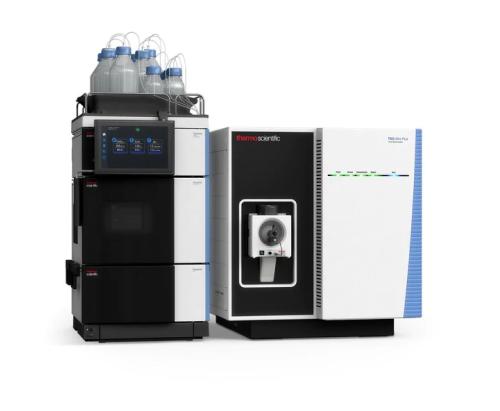 TSQ Altis Triple Quadrupole MS (Figure from Thermo Scientific)
TSQ Altis Triple Quadrupole MS (Figure from Thermo Scientific)
Gas Chromatography–Mass Spectrometry (GC-MS) (for volatile matrices or derivatized cadaverine)
Instrument: Agilent 7890B GC System coupled with 5977B MSD
Method Highlights:
- Derivatization: Typically with pentafluoropropionic anhydride (PFPA) or dansyl chloride
- Injection mode: Splitless for trace analysis
- Detection range: Low ppb to high ppm
- Column: HP-5MS UI, 30 m × 0.25 mm × 0.25 μm
- Application: Ideal for food matrices and volatile derivatives of cadaverine
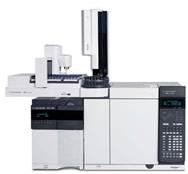 Agilent 7890B-5977B (Figure from Agilent)
Agilent 7890B-5977B (Figure from Agilent)
Ultra-Performance Liquid Chromatography with Fluorescence Detection (UPLC-FLD)
Instrument: Waters ACQUITY UPLC H-Class System with FLR Detector
Method Highlights:
- Derivatization reagent: o-Phthalaldehyde (OPA)
- Excitation/emission: 340/455 nm
- Advantages: Cost-effective quantification in food and microbial samples
- Use case: High-throughput screening where MS-level specificity is not required
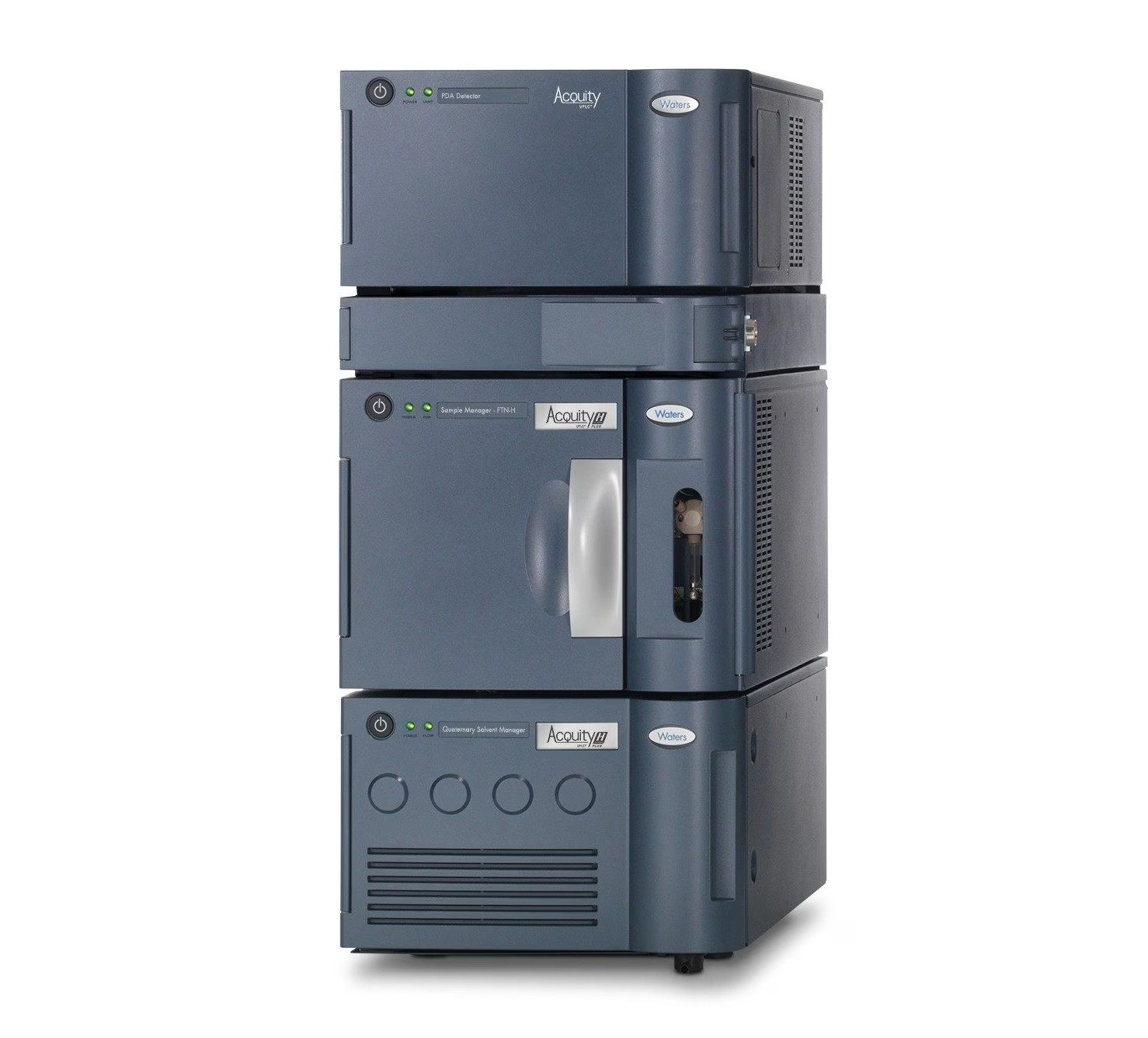 Waters ACQUITY UPLC System (Figure from Waters)
Waters ACQUITY UPLC System (Figure from Waters)
Our Cadaverine Assay Workflow
1. Sample Submission
Accepts serum, plasma, fermentation broth, food, soil, plant extracts, microbial cultures
2. Sample Preparation
- Matrix-specific extraction and purification
- Derivatization (e.g., dansylation or OPA) to enhance detection
3. Instrumental Analysis
- LC-MS/MS (TSQ Altis) or GC-MS (Agilent 7890B/5977B) based on matrix and volatility
- Internal standards applied for quantification
4. Data Processing & Quality Control
- MRM signal integration, calibration curve fitting
- Includes blanks, replicates, and spiked controls
5. Report Delivery
- Quantitative data, chromatograms, QC metrics
- Optional expert consultation on request
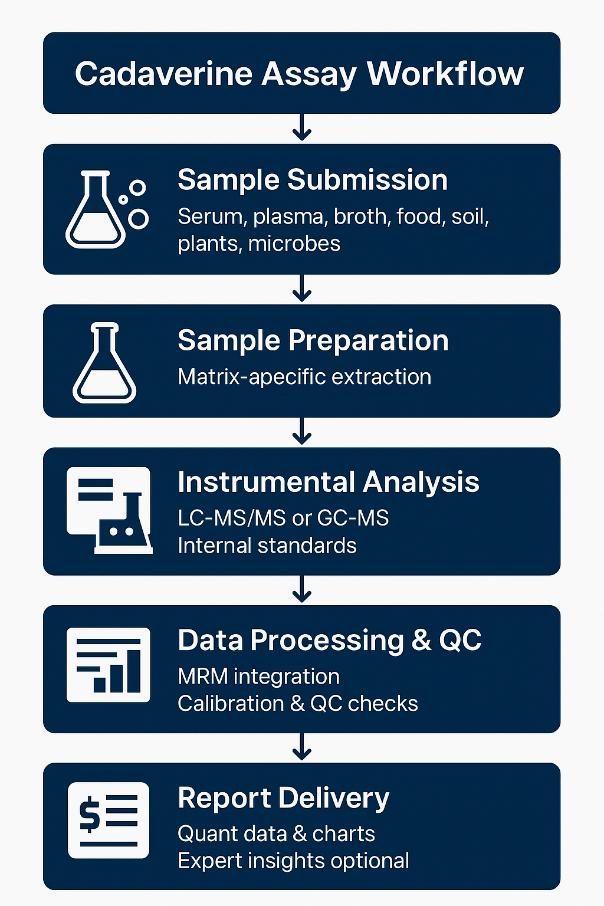
Sample Requirements for Cadaverine Analysis Service
| Sample Type | Volume/Amount | Storage Conditions | Container Type | Remarks |
|---|---|---|---|---|
| Blood Serum | 1-2 mL | Store at -20°C or below | Clean, sterile vial | Avoid hemolysis |
| Urine | 10 mL | Refrigerate at 4°C | Sterile polypropylene tube | Collect midstream sample |
| Tissue Homogenate | 0.5-1 g | Freeze immediately at -80°C | Cryovial | Minimize thaw cycles |
| Food Sample | 10 g | Refrigerate or freeze | Food-grade sterile container | Homogenize before analysis |
| Environmental Water | 500 mL | Store at 4°C, analyze ASAP | Clean glass or plastic bottle | Avoid contamination |
Demo Results
Cadaverine Analysis Service Case Study
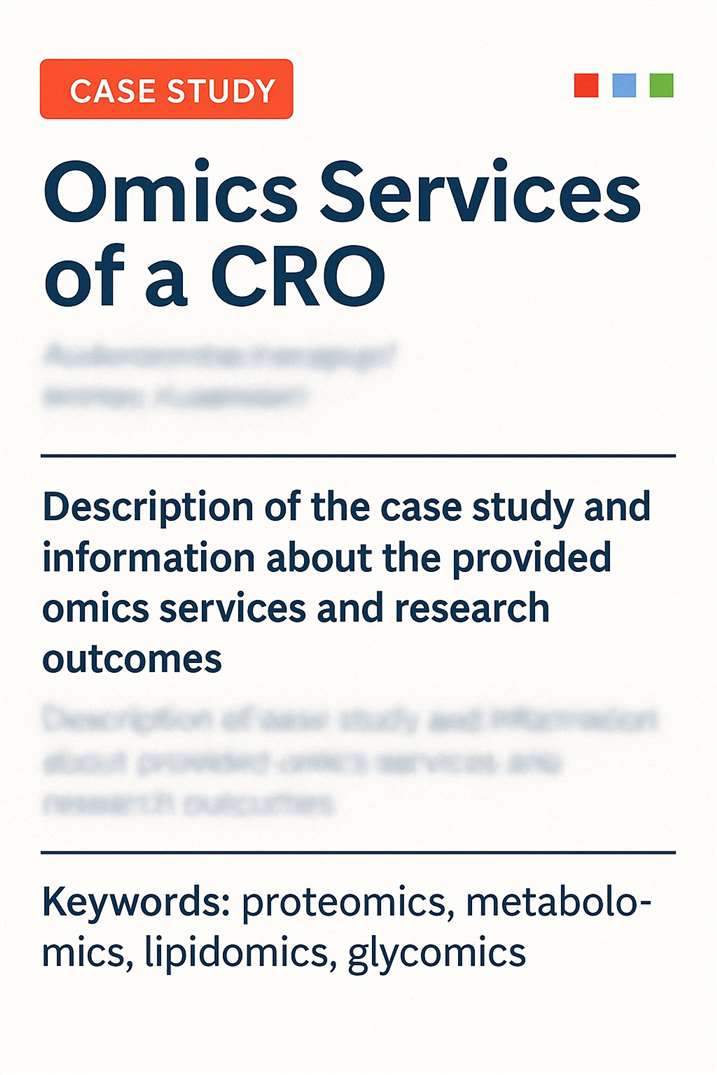
Title: Polyamine metabolism impacts T cell dysfunction in the oral mucosa of people living with HIV
Journal: Nature Communications
Published: 2023
- Study Summary
- Background
- Methods
- Results
- Reference
This study reveals that HIV infection disrupts polyamine metabolism in the oral mucosa, leading to increased polyamine synthesis that drives T cell dysfunction. Elevated polyamine levels correlate with an imbalance between dysfunctional regulatory T cells and helper T cells. Blocking polyamine synthesis reverses this dysfunction, highlighting its key role in immune impairment during HIV infection.
HIV infection causes chronic immune dysfunction, particularly in the oral mucosa, despite antiretroviral therapy. Dysregulated T cell subsets and inflammation persist, linked to altered polyamine metabolism. This study shows that changes in polyamine pathways disrupt the balance of T helper and regulatory T cells, driving immune dysfunction and chronic inflammation in people living with HIV.
Human Samples
Gingival biopsies and saliva from healthy individuals and PLWH were collected with informed consent, approved by the University Hospitals Cleveland Medical Center Institutional Review Board. Tonsil samples, obtained from tonsillectomies, were processed for single-cell suspensions.
Polyamines in cell lysates and supernatants were quantified using a fluorimetric method. Samples were processed to remove proteins before analysis, with concentrations normalized to viable cell numbers.
Salivary Metabolome Analysis
Saliva samples were analyzed by LC-MS after methanol extraction. UPLC and Q Exactive MS were used for metabolite quantification.
RNA Sequencing and Metabolome Data Analysis
RNA sequencing of gingival cells was performed to identify gene expression changes. Data were integrated with metabolome results, analyzed using statistical tests including t-tests and ANOVA.
Targeted Polyamine Quantification
Polyamines were quantified by LC-MS after derivatization with dansyl chloride, with analysis performed using UPLC-MRM/MS.
Statistical Analyses
Statistical significance was assessed using Prism 8 software with Mann–Whitney tests, ANOVA, and correlation analysis.
![]() How Creative Proteomics Can Help?
How Creative Proteomics Can Help?
- Expert sample preparation and metabolite extraction ensuring high-quality input for LC-MS analysis.
- Advanced LC-MS and targeted UPLC-MRM/MS platforms for comprehensive metabolomic profiling and precise quantification of metabolites like polyamines.
- Rigorous quality control workflows to guarantee reproducibility and data integrity.
- Integrated bioinformatic analysis, including multivariate statistics and pathway/network mapping, facilitating deeper biological insights from metabolomic data.
- Seamless integration with transcriptomic or other omics datasets to support systems-level understanding.
Impact on T Cell Subsets:
HIV-1 infection significantly increases the frequency of TregDys cells (FOXP3+ PD-1+ IFN-γ+) in the CD4+ T cell population.
There is a marked reduction in Th17 cells in the oral mucosa of HIV+ patients, even after cART therapy.
Effects of Polyamines:
Polyamines elevate EIF5A and its hypusinated form while decreasing ODC-1 expression in CD4+ T cells.
Exogenous polyamines do not induce TregDys cells by increasing IFN-γ levels; instead, they promote FOXP3 expression in Th1-like cells and enhance TregDys proliferation.
Spermidine and other polyamines contribute to the dysregulation of Th1-like cells and increase TregDys expansion, with a corresponding rise in Amphiregulin (AREG) and KI-67 expression.
Correlation with Oral Mucosa:
The ratio of TregDys to Th17 cells is significantly higher in the oral mucosa of people living with HIV compared to healthy controls.
Elevated levels of putrescine in saliva positively correlate with increased TregDys/Th17 ratios and Th cell hyperactivation in the oral mucosa.
Overall Summary:
HIV-1 infection induces a shift in T cell subsets, increasing TregDys cells and reducing Th17 cells, which is linked to elevated polyamine levels.
Polyamines upregulate EIF5A and promote TregDys proliferation while inhibiting IFN-γ expression in CD4+ T cells.
Elevated putrescine levels and increased TregDys/Th17 ratios in the oral mucosa of HIV+ individuals further support the role of polyamines in T cell dysregulation and immune hyperactivation.
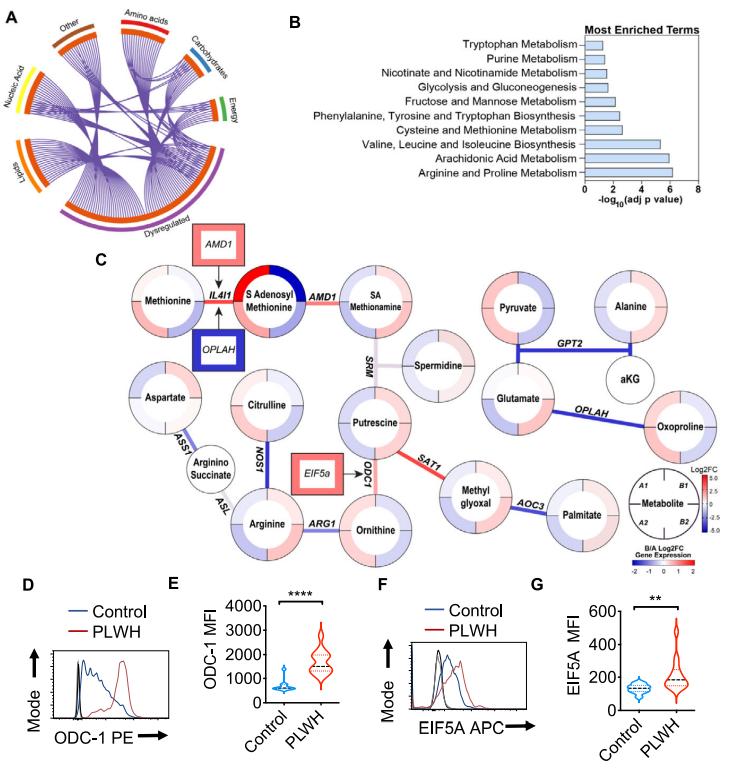 Salivary metabolome and gingival immune cell analyses show: (A) Circos plot linking dysregulated PLWH genes to KEGG pathways; (B) Enriched terms by –log10(p-value); (C) Arginine-proline metabolism changes (Log2FC); (D, F) Flow cytometry histograms of ODC-1 and EIF5A in CD4+ T cells from controls vs. PLWH; (E, G) Quantification of fluorescence intensity (median ± SEM).
Salivary metabolome and gingival immune cell analyses show: (A) Circos plot linking dysregulated PLWH genes to KEGG pathways; (B) Enriched terms by –log10(p-value); (C) Arginine-proline metabolism changes (Log2FC); (D, F) Flow cytometry histograms of ODC-1 and EIF5A in CD4+ T cells from controls vs. PLWH; (E, G) Quantification of fluorescence intensity (median ± SEM).
Reference
- Mahalingam, S. S., et al. "Polyamine metabolism impacts T cell dysfunction in the oral mucosa of people living with HIV." Nature Communications 14.1 (2023): 399. https://doi.org/10.1038/s41467-023-36163-2
FAQ of Cadaverine Analysis Service
What factors can affect the accuracy of cadaverine measurements in biological samples?
The accuracy of cadaverine measurements can be influenced by several factors, including sample handling, storage conditions, and matrix complexity. Proper sample preservation is critical, as cadaverine can degrade or react with other compounds if not stored at the correct temperature, typically at -80°C for biological samples like serum or tissue. In addition, matrix effects such as interference from other biogenic amines or proteins in the sample can affect the precision of detection. At Creative Proteomics, we use techniques like precolumn derivatization to minimize interference and improve sensitivity, ensuring more accurate results.
How does the presence of other biogenic amines, like putrescine, affect cadaverine analysis?
Biogenic amines, such as putrescine, share similar chemical structures with cadaverine and can co-occur in biological samples, especially during tissue decomposition or in cases of metabolic imbalance. This can lead to cross-interference in the analysis, especially when using methods like HPLC or GC-MS. However, Creative Proteomics employs advanced separation techniques, including mass spectrometry (LC-MS/MS), to differentiate between closely related amines and accurately quantify cadaverine, even in complex samples with high levels of other amines.
Can cadaverine levels be used as a biomarker for specific diseases or conditions?
Yes, elevated cadaverine levels are often associated with certain metabolic disorders, particularly those related to lysine metabolism deficiencies. In clinical research, monitoring cadaverine concentrations can help diagnose or track diseases involving abnormal amino acid metabolism. Additionally, cadaverine can be used as a marker in forensic and toxicological studies to assess postmortem decomposition stages. Creative Proteomics provides customized cadaverine analysis to support disease research and forensic applications, ensuring accurate biomarker detection.
How do environmental factors influence cadaverine formation, and can they affect analysis results?
Environmental factors such as temperature, humidity, and oxygen levels can significantly impact the rate of protein decomposition and cadaverine formation in tissues. For instance, higher temperatures accelerate the putrefaction process, leading to more rapid cadaverine production, while anaerobic conditions can alter the metabolic pathways of bacterial breakdown. These environmental influences need to be considered when interpreting cadaverine levels in forensic or food spoilage studies. At Creative Proteomics, we provide context-based interpretation of cadaverine data, considering environmental conditions that may affect formation rates.
What are the challenges in detecting cadaverine in food products, and how are they addressed?
Detecting cadaverine in food products, particularly in meat and fish, can be challenging due to the complexity of the food matrix and the presence of other spoilage-related amines. The fat content, proteins, and water content in food can interfere with detection methods. At Creative Proteomics, we overcome these challenges by using advanced sample preparation techniques such as homogenization and pre-filtration, along with highly sensitive detection methods like GC-MS. This ensures accurate detection of cadaverine, even in complex food matrices, helping assess food safety and spoilage levels.
What are the detection limits for cadaverine in different sample types, and how does Creative Proteomics ensure sensitivity?
Detection limits for cadaverine can vary depending on the sample type and the analytical technique used. For example, LC-MS/MS and GC-MS offer extremely low detection limits, often in the nanomolar range, making them ideal for detecting trace levels of cadaverine in biological fluids or tissues. To ensure high sensitivity, Creative Proteomics uses precolumn derivatization for HPLC and mass spectrometric techniques that enhance the detection of even the smallest quantities of cadaverine. This ensures that we can accurately measure cadaverine levels, even in samples with low concentrations.
How are cadaverine levels in in vitro studies relevant to human in vivo conditions?
Cadaverine levels in in vitro studies, such as those using cultured cells or tissues, can offer valuable insights into metabolic pathways, enzyme activity, and cellular response to lysine decarboxylation. However, translating these findings to in vivo human conditions requires careful consideration of factors such as systemic metabolism, organ-specific responses, and interactions with other biomolecules. At Creative Proteomics, we help researchers correlate in vitro data with potential in vivo implications, offering a comprehensive understanding of cadaverine's role in biological systems.
Learn about other Q&A about proteomics technology.
Publications
Here are some of the metabolomics-related papers published by our clients:

- Polyamine metabolism impacts T cell dysfunction in the oral mucosa of people living with HIV. 2023. https://doi.org/10.1038/s41467-023-36163-2
- Methyl donor supplementation reduces phospho‐Tau, Fyn and demethylated protein phosphatase 2A levels and mitigates learning and motor deficits in a mouse model of tauopathy. 2023. https://doi.org/10.1111/nan.12931
- A human iPSC-derived hepatocyte screen identifies compounds that inhibit production of Apolipoprotein B. 2023. https://doi.org/10.1038/s42003-023-04739-9
- The activity of the aryl hydrocarbon receptor in T cells tunes the gut microenvironment to sustain autoimmunity and neuroinflammation. 2023. https://doi.org/10.1371/journal.pbio.3002000
- Lipid droplet-associated lncRNA LIPTER preserves cardiac lipid metabolism. 2023. https://doi.org/10.1038/s41556-023-01162-4
- Inflammation primes the kidney for recovery by activating AZIN1 A-to-I editing. 2023. https://doi.org/10.1101/2023.11.09.566426
- Anti-inflammatory activity of black soldier fly oil associated with modulation of TLR signaling: A metabolomic approach. 2023. https://doi.org/10.3390/ijms241310634
- Plant Growth Promotion, Phytohormone Production and Genomics of the Rhizosphere-Associated Microalga, Micractinium rhizosphaerae sp. 2023. https://doi.org/10.3390/plants12030651
